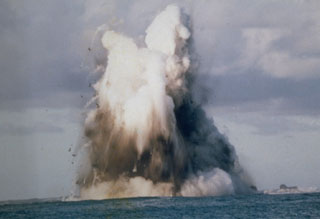Report on Nishinoshima (Japan) — 24 June-30 June 2020
Smithsonian Institution / US Geological Survey
Weekly Volcanic Activity Report, 24 June-30 June 2020
Managing Editor: Sally Sennert.
Please cite this report as:
Global Volcanism Program, 2020. Report on Nishinoshima (Japan) (Sennert, S, ed.). Weekly Volcanic Activity Report, 24 June-30 June 2020. Smithsonian Institution and US Geological Survey.
Nishinoshima
Japan
27.247°N, 140.874°E; summit elev. 100 m
All times are local (unless otherwise noted)
During an overflight of Nishinoshima on 29 June Japan Coast Guard observers noted black ash plumes vigorously rising from the central crater to more than 3.4 km (11,200 ft) a.s.l. A possible collapse of the SW part of the main crater was evident in photographs taken during the overflight. Strombolian explosions ejected lava above the cone and lava traveled SW, reaching the ocean and producing steam plumes. Discolored yellow-green water was visible as far as 1 km offshore. The marine exclusion zone was defined as a radius of about 2.6 km from the island.
Geological Summary. The small island of Nishinoshima was enlarged when several new islands coalesced during an eruption in 1973-74. Multiple eruptions that began in 2013 completely covered the previous exposed surface and continued to enlarge the island. The island is the summit of a massive submarine volcano that has prominent peaks to the S, W, and NE. The summit of the southern cone rises to within 214 m of the ocean surface 9 km SSE.
Source: Japan Coast Guard

